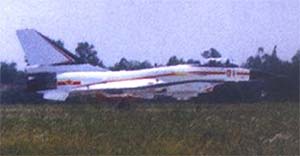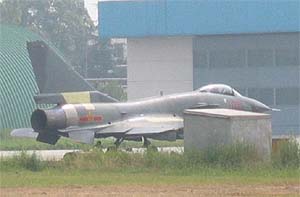Air-Attack.com > Military Systems > Chengdu J-10
Chengdu J-10

China's fourth generation multi-role fighter aircraft
The Chengdu Aircraft Industry Co. (CAC) J-10, China's fourth generation multirole fighter aircraft, will be the most advanced fighter in the PLAAF's inventory once introduced to service. The J-10 programme (Project No.10) has been under way for over a decade. Six prototypes have been built by 2001 and these aircraft are reportedly undertaking extensive test flights at CAC's test site.
The first J-10 fighter model photo revealed by an internal press of the Chinese Aircraft Industry in the mid-1990s |
The J-10 programme can trace its origins back to the J-9, a Mach 2.5 canard-delta fighter, which is a blend mixture of MiG-23 and Saab JA-37 Viggen. The J-9 project was transferred from Shenyang to Chengdu in 1969 and was later cancelled due to insufficient funds.
Work on the J-10 began in the 1980s as a counter to the Soviet Union?s fourth-generation fighters, the MiG-29 and Su-27. The original mission was air superiority, but the break-up of the Soviet Union and changing requirements shifted development towards a multirole fighter to replace the Shenyang J-6 (MiG-19) and Chengdu J-7 (MiG-21), which are backbone of China?s air force.
The Chinese President Jiang Zemin and the J-10 test pilot at CAC. In 1998, Jiang went to CAC to offer his congratulations to the successful test flight of the J-10 |
Originally based on the cancelled Israel Avation
Industry (IAI) 'Lavi' lightweight fighter, the J-10's development
has experienced some major re-design work due to the changes of
requirements.
The development of J-10 has proven to be tortuous.
The prototype was rumored to have first flown in 1996, but the project suffered a serious setback in late 1997 when the 02 prototype lost control and crashed, as the result of certain system failure, presumably with either the FBW system or the engine.
After careful redesign and extensive ground test, the successful flight of the new prototype (J-10A?) took place on March 23, 1998, which put the project back on the track.
Initially 6 prototypes (serial numbers 1001-1006) were built undergoing various static and flight tests at CAC in Chengdu and at the CFTE in Yanliang. Subsequently 3 more prototypes were built (1007-1009) as the project is moving to the pre-production phase while PLAAF remains fully committed.
A carrier based version (J-10B?) was rumored but never confirmed. The earliest service date was expected to be 2005.
DESIGN FEATURES
The J-10 has a rectangle belly air intake, with low-mounted delta wings, a pair of front canard wings, a large vertical fin, and two underfuselage fins. The design is aerodynamically unstable, to provide a high level of agility, low drag and enhanced lift. The pilot controls the aircraft through a computerised digital fly-by-wire system, which provides artificial stabilisation and gust elevation to give good control characteristics throughout the flight envelope.
COCKPIT
The J-10's cockpit is fitted with three flat-panel liquid crystal multifunction displays (MFDs), including one colour MFD, wide field-of-view head-up display (HUD), and possibly helmet-mounted sight (HMS). It is not know whether the HMS is the basic Ukrainian Arsenel HMS copied by China's Luoyang Avionics, or a new helmet display featured briefly at the 2000 Zhuhai air show.The pilot manipulates the J-10 by the 'Iron Bird' flight-control system, a quadruple (four channels) digital fly-by-wire (FBW) based on the active control technology tested by the Shenyang J-8IIACT demonstrator aircraft. The pilot will also be aided by advanced autopilot and air data computer.
The first convincing photo of the J-10 prototype 01 anonymously published on Internet |
RADAR:
Several options are available for the J-10 fighter. These include the Russian Phazotron Zhuk-10PD, a version of the system in later Su-27s, with 160 km search range and ability to track up to six targets. Israel has offered its Elta EL/M-2035 radar for competition. In addition, China has also developed its own design JL-10A, which might be assisted by Russian technology.For low-level navigation and precision strike, a forward-looking infrared and laser designation pod is likely to be carried F-16-style on an inlet stores station. A Chinese designed pod similar to the Israeli Rafael Litening was revealed at the 1998 Zhuhai air show.
ENGINE:
The single-seat, single-engine J-10 is similar in size to the Lockheed Martin F-16C/D. The initial batch J-10s are going to be powered by 27,500 lb-thrust (120 kN) Russian Lyulka Saturn AL-31F turbofan, the same power plant also being used by Chinese air force Sukhoi Su-27s and Su-30s. Some report indicated that 100 AL-31F engines with features specially designed for the J-10 have already been delivered to China in early 2001.China is also developing its own WS-10 turbofan power plant, and it could be fitted on the later versions of the J-10. According to the U.S. intelligence, the J-10 might be slightly more manoeuvrable than the F-18E/F, which is slated to become the U.S. Navy's next principal combat aircraft.
ARMARMENTS:
The fixed weapon of the J-10 is a 23 mm internal cannon.The J-10 has 11 stores stations - six under the wing and five under the fuselage. The inner wing and centre fuselage stations are plumped to carry external fuel tanks. Fixed weapon is a 23-mm inner cannon hidden inside fuselage.
A J-10 prototype parking outside the hanger of the CAC test site |
In addition to the PL-8 short-range infrared-guided air-to-air missile reportedly derived from Israeli Rafael Python-3 technology, the J-10 could also carry Russian Vympel R-73 (AA-11) short-range and R-77 (AA-12) medium-range missiles equipped by Chinese Flankers. It may also be fitted with indigenously developed PL-11 or PL-12 medium-range AAM for BVR combat.
For ground attack missions, the J-10 will carry laser-guided bombs, YJ-8K anti-ship missile, as well as various unguided bombs and rockets. Some missiles currently under development such as the YJ-9 ramjet-powered anti-radiation missile may also be carried by the J-10.
UPGRADE:
An all-aspect vectored-thrust version of the AL-31F was revealed for the first time at Zhuhai Air Show 1998, leading to speculation that this advanced engine may wind up on the J-10, potentially conferring phenomenal manoeuvrability. It also projects that a naval variant of the J-10, perhaps with twin-engines, may equip a possible Chinese aircraft carrier. China might also be considering upgrading the J-10 with more advanced phased-array radar to improve its combat capabilities.
Specifications
| Primary Function: | Multirole fighter | Builder: | Chengdu Aircraft Industry Co. (CAC) |
Power Plant: | One Lyulka Saturn AL-31F turbofan | Thrust: | 17,857 lb (79.43 kN) dry and 27,557 lb st (122.58 kN) with afterburning | Length: | 14.57 m | Height: | 4.78 m | Wingspan: | 8.78 m |
Wing Area: | 33.1 m2 | Speed: | Mach 1.2 (sea-level) or Mach 2.0 (high altitude) | Ceiling: | 18,000 m | Maximum Takeoff Weight: | 18500 kg | Range: | combat radius of 1,000 km | Armament: | One 23 mm internal cannon, 4500 kg payload on 11 hardpoints | First Flight: | 1996 | Date Deployed: | Around 2005 |
NOTE: Information and images from www.sinodefence.com






